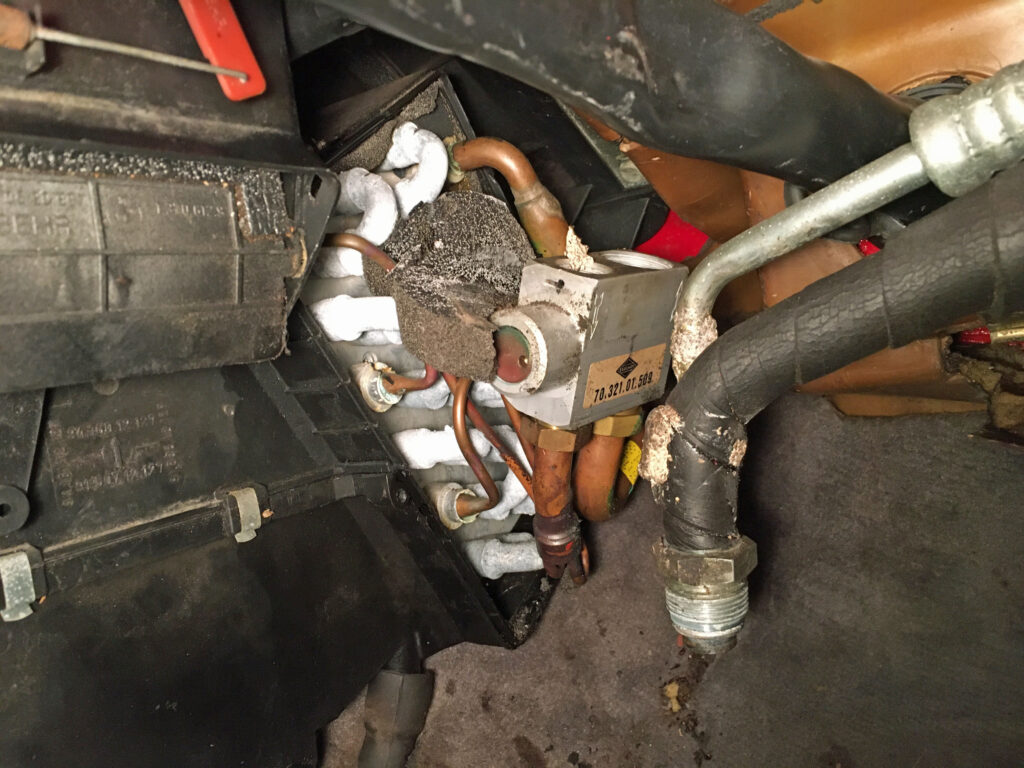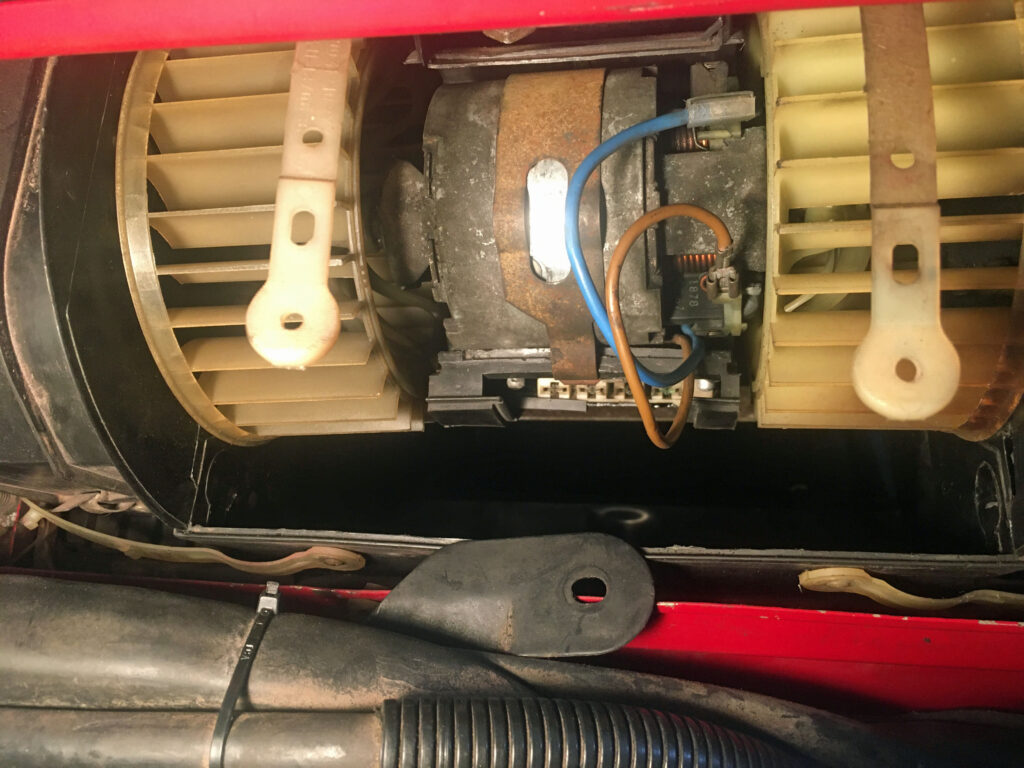The story thus far: I jumped at the opportunity to buy a running essentially rust-free 1988 E30 325is near Albany NY for five grand. I knew that the car had a rebuilt salvage title from an event in 1992, but I didn’t care. I shot out there with my truck, a U-Haul trailer, and cash. It was raining, so I was brutally efficient about verifying the condition of the car. Rust-free? Pretty much, yeah. Runs? 30 seconds around a muddy parking lot, check. Right. Cash for title, load it, outa here. Done. Boom. It wasn’t until I got it home and began tearing into the timing belt and water pump replacement that I learned that the car is something of a Frankenthirty (which is, in fact, now its name), with the firewall on back belonging to a facelifted model-year ’88 car, the front body panels as well as the eta engine from a pre-facelift donor ’87 325e, and the components in the engine compartment an odd mashup of the two.
In addition, there were mice. Of course there were mice. I mean I’d gotten everything else wrong about the car. Why wouldn’t there be mice?
When I bought the car, I did notice the strong urine smell in the trunk emanating from a visible collection of detritus in the left forward corner. I didn’t really think much of it. According to the CarFax, the car had been registered and inspected until two years ago. So it sat last for a bit and had some junk in the trunk. Big deal. It wasn’t as if the interior stank. In my 30-second rainy parking lot drive, my mouse-dar wasn’t set off.
Boy did I get this wrong.
Once the car was sitting in my garage, I began to notice a strong mouse odor. In addition to what was in the the trunk, I pulled up the back seat and found a good-sized mouse nest with a desiccated body in it. Having dealt with several mouse-infested vehicles over the years, I know the drill. Locate and remove the bulk contamination (e.g., the nest, the bodies, the turds). Clean the affected area thoroughly. Treat it with enzyme-based cleaner (I use Rocco & Roxie stain and odor eliminator). Lysol and other spray products are not a substitute for this process. You’ll never eliminate the smell if the source is still present. But this was contained. Suck it up, wipe it down. Easy peasy, right?

The motherlode? Not even close.
Unfortunately the smell persisted both inside the car and in the engine compartment. As a test, I briefly turned on the blower fan and nearly gagged. I could see a mouse nest through the plastic vents at the top of the cowl. I popped them off and found that the entire cowl was packed with nesting material.

This was just the tip of the mouseberg.
It wasn’t immediately clear to me how to access the interior of the cowl, so I used a coat hanger with a hook bent into the end combined with a narrow nozzle on the hose of the shop vac to drag-and-suck out what I could. Eventually I figured out that the innards of the cowl are accessible by pulling up the rubber trim strip and removing a vertical panel that runs along the top of the firewall. With that removed, the extent of the contamination became clear.

I can’t look.
I’d already fished out the bulk of the nest with the coat hanger, but I could see that mice had gotten past the squirrel-cage fan and into the climate control box (the E30 is new enough that a single box hoses both the a/c evaporator core as well as the heater core).

Way not good #1.

Way not good #2. That’s the evaporator core at the top of the climate control box.
Clearly the thing to do was to yank out the entire climate control box so it could be disassembled and thoroughly cleaned. However, searching online for the procedure to do so, the only videos I found were part of full-on interior stripping where the dashboard was removed first. I suspected that the could be removed without pulling the dash, but as my attraction to the car had taken a nose dive by it being a Franken-car and having the eta engine instead of the high-revving “i” engine, I didn’t want to go to that level of effort.
So I settled on a more arthroscopic approach: I pulled the blower fan out from the cowl, then from inside the car I slid both the heater core and the evaporator core out of the climate control box (this is a huge generational advantage that the E30 has over other vintage BMWs where these cores are inside sealed boxes that have to come out and be disassembled).

The heater core slides out into the driver’s-side footwell.

Out comes the evaporator with the expansion valve attached into the passenger footwell.
With the fan and both cores removed, I could then reach inside the climate control box from both the top and bottom and use the 1-2-3 punch of vacuum nozzle, Clorox wipes, and enzyme-based cleaner until all detritus was removed. While this will never be as good as removal, disassembly, and internal pressure-washing of the entire box, my hope was that it would be good enough.
I found that the bulk of the contamination stopped at the evaporator core. That was good for the rest of the box, but bad for the evap core; despite repeated washing and soaking with the enzyme-based cleaner, it still smelled. I sourced a replacement used evap core on eBay for $30 shipped. The squirrel-cage fans on the blower motor responded pretty well to multiple soaking in enzyme-based cleaner, careful scrubbing with a test tube brush, and rinsing. The heater core cleaned up fine.

Yeah, no.

Oh that is so much better.
I reassembled the system enough to test it, and my arthroscopic method seemed to have the intended result. That is, it pulled the ventilation system back from “OH GOD SHUT IT OFF” to far-from-fresh-as-a-daisy-but-not-blatantly-offensive. My wife would never deign to ride in the car smelling like this, but it was no longer awful. And air and time will likely make it better.
With the timing belt and water pump installed and the cabin no longer triggering a gag reflex, the car was nearly ready for a test drive so I could get a sense of what this thing that I’d bought actually was. And for that, you’ll need to tune in next week.
—Rob Siegel
____________________________________
Rob’s newest book, The Best of The Hack Mechanic, is available here on Amazon, as are his seven other books. Signed copies can be ordered directly from Rob here.
Tags: cleaning mice nesting smell



















